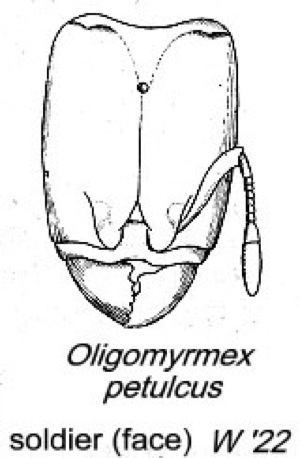Oligomyrmex (Aeromyrma) petulcus (Wheeler)
Major -   Type location Zaïre
(Aëromyrma petulca, Wheeler, 1922: 166, illustrated; in Oligomyrmex by Ettershank, 1966:
124)
from Malela, collector Lang & Chapin; major only described.
Known from a single specimen Type location Zaïre
(Aëromyrma petulca, Wheeler, 1922: 166, illustrated; in Oligomyrmex by Ettershank, 1966:
124)
from Malela, collector Lang & Chapin; major only described.
Known from a single specimen  . .
|
 Wheeler's
(1922) description is - Wheeler's
(1922) description is -
MAJOR - Length 2.5 mm. Head suboblong, nearly
one and one-half times as long as broad, with feebly convex sides and
rather deeply and angularly excised posterior border. Anterior ocellus
well developed; eyes very small, consisting of about six ommatidia,
situated at the anterior third of the head. Posterior corners of the
latter with a low but distinct ridge produced on each side into a
minute tooth. Mandibles convex, with 4 small, subequal, rather acute
apical teeth, and a large blunt and flattened basal tooth. Clypeus
flat, ecarinate, its anterior border feebly and sinuately excised in
the middle, its posterior portion narrow, rectangular, extending back
between the diverging frontal carinae. Frontal groove distinct.
Antennae 10-jointed; scapes rather slender and curved at the base,
reaching to the middle of the sides of the head; joints 2 to 7 of the
funiculus minute, subequal, nearly as broad as long (somewhat too long
in the figure); club a little shorter than the remainder of the
funiculus, with the basal joint longer than broad and about one-third
as long as the terminal joint. Thorax decidedly shorter and narrower
than the head; pro- and mesonotum convex, steep in front, rounded
above; promesonotal suture distinct; mesonotum subcircular; metanotal
sclerite distinct. In profile the dorsal outline of the mesonotum
slopes backward continuously with the base of the propodeum without a
distinct impression at the metnotal groove. Propodeum with a small
tooth on each side, its declivity longer than its base, rather steeply
sloping. Petiolar node compressed anteroposteriorly, in profile with a
rather angular summit, from above transverse; postpetiole transversely
elliptical and somewhat broader than the petiole, with a blunt ventral
tooth. Gaster voluminous, distended with a transparent liquid, elongate
elliptical, longer than the remainder of the body, its anterior border
straight in the middle. Legs short.
Subopaque; mandibles, posterior portion of clypeus, frontal area,
mesonotum, and gaster shining; mandibles sparsely and indistinctly
punctate; head finely and regularly longitudinally rugulose; sparsely
and rather coarsely punctate posteriorly; gaster with fine, scattered,
piligerous punctures. Hairs yellowish, moderately abundant, suberect,
of uneven length, most conspicuous on the dorsal surface; very short,
dense and appressed on the appendages. Ferruginous red; legs and
antennae paler and more yellowish; gaster dark brown above, with the
venter and bases and apical borders of the segments broadly yellowish.
Described from a single specimen taken by Lang and Chapin at Malela
"from a small mushroom-shaped termitarium," probably belonging to a
colony of Eutermes fungifaber Sjöstedt.
A. petulca differs from africanus Forel
from the Kalahari [Botswana] in its slightly smaller size, darker
color, in having the postpetiole only slightly broader than the petiole
(nearly twice as broad in africanus), in possessing propodeal
teeth and longitudinal rugae on the head. In africanus, the
head is finely reticulate and the remainder of the body is evidently
more shining than in petulcus. In nossindambo [from
Magagascar] the head is broader and less sharply rugulose, the thorax
is more deeply impressed at the metanotal groove suture, the antennal
scapes are much shorter, the anterior ocellus is smaller and the color
is paler.
Forel states that the gaster of the africanus soldier is
"transparent yellow," which indicates that it was full of a clear
liquid as in petulcus. This condition is seen also in the
soldiers of many species of Pheidole in Australia and in our
Southern States and seems to indicate that this caste in the two genera
mentioned often functions as replete or food- storage individuals as in
the honey ants (Myrmecocystus, Leptomyrmex, Melophorus,
Plagiolepis, and Prenolepis).
NOTE: This
specimen from the holotype images (see below) is a queen. The
wing attachments are clear and the central ocellus on the head appears
not to occur in major workers of the genus.
|
 The
photomontage is collated from the AMNH Congo
Expedition website. The photographs of the holotype specimen (labelled
as Aeromyrma petulca) were taken by Brian Fisher as part of the
VCA project at the California Academy of Sciences - http://www.antweb.org/specimen.do?name=casent0003148. The
photomontage is collated from the AMNH Congo
Expedition website. The photographs of the holotype specimen (labelled
as Aeromyrma petulca) were taken by Brian Fisher as part of the
VCA project at the California Academy of Sciences - http://www.antweb.org/specimen.do?name=casent0003148.
|
|